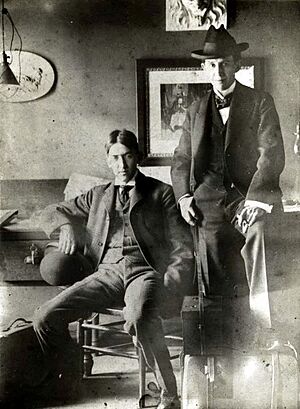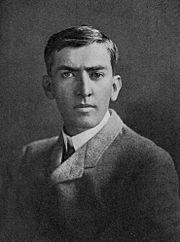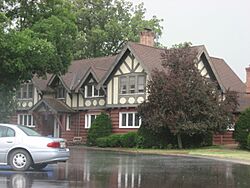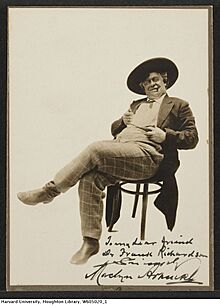George Ade facts for kids
Quick facts for kids
George Ade
|
|
|---|---|

Ade in 1904
|
|
| Born | February 9, 1866 Kentland, Indiana, U.S.
|
| Died | May 16, 1944 (aged 78) Brook, Indiana, U.S.
|
| Resting place | Fairlawn Cemetery, Kentland, Indiana |
| Occupation | Writer, newspaper columnist, and playwright |
| Parents |
|
George Ade (born February 9, 1866 – died May 16, 1944) was a famous American writer. He was known for his newspaper columns, plays, and humorous stories. He became very popular around the year 1900.
Ade wrote a column called "Stories of the Streets and of the Town." It used everyday language and slang to describe life in Chicago. He also wrote funny stories called "fables in slang." These stories used common speech and special capitalization for characters' words.
His fables made him rich and famous as a humorist. People even called him the "Aesop of Indiana." Some of his early popular books include Artie (1896) and Fables in Slang (1900). He also wrote plays for Broadway. These included The Sultan of Sulu (1901), The County Chairman, and The College Widow (both in 1904). Ade also wrote movie scripts.
George Ade was part of a "Golden Age of literature" in Indiana. This was during the early 1900s. Other famous writers from Indiana at that time included Booth Tarkington and James Whitcomb Riley.
Ade graduated from Purdue University. He started his career as a newspaper reporter in Lafayette, Indiana. Later, he moved to Chicago to work for the Chicago Daily News. Besides writing, Ade loved to travel, play golf, and host friends at his home, Hazelden. This estate was near Brook, Indiana. He also supported Purdue University. He helped fund buildings like the Memorial Gymnasium and the Memorial Union Building. He also helped create Ross–Ade Stadium, which is named after him and David Edward Ross.
Contents
Early Life and School Days
George Ade was born in Kentland, Indiana, on February 9, 1866. His father, John Ade, was a farmer and banker. His mother was Adaline Wardell (Bush) Ade. George was one of seven children in his family.
He loved to read from a young age. But he did not like farm work. He graduated from Kentland High School in 1881. After another year of high school, he went to Purdue University in 1883 on a scholarship.
At Purdue, Ade studied science. But he became more interested in college social life and the theater. He joined the Sigma Chi fraternity. There, he met John T. McCutcheon, who became a lifelong friend and famous cartoonist. Ade earned a Bachelor of Science degree from Purdue in 1887. He thought about becoming a lawyer but chose writing instead.
Ade's Writing Career
Starting as a Newspaper Reporter
After college, George Ade began his writing career in Lafayette, Indiana. He worked as a reporter for local newspapers. By 1890, he moved to Chicago, Illinois. He joined his college friend, John T. McCutcheon, at the Chicago Daily News. McCutcheon worked there as an illustrator.
Ade's first job was writing a daily weather story. He also covered big news events. These included a boxing match and the World's Columbian Exposition (Chicago World's Fair) in 1893.
Becoming a Syndicated Columnist
While working for the Chicago Record, Ade became known for his humorous stories. These stories turned everyday events into funny observations. In 1893, he started writing a daily column called "Stories of the Streets and of the Town." McCutcheon often drew pictures for it.
Ade used street language and slang to describe Chicago life. He created characters like Artie, an office boy, and Pink Marsh, a shoeshine boy. Collections of these columns were published as books. This made his column even more popular.
In 1897, Ade started writing his "fables in slang." These were humorous stories with a moral, like Aesop's fables. They used common speech and Ade's unique capitalization style. He left the Chicago Record in 1899 to write these fables for newspapers across the country. His book Fables in Slang (1900) was very popular. He continued to publish collections of his fables for nearly twenty years.
Writing Plays and Books
After his newspaper columns became nationally known, Ade started writing plays. His first play for Broadway was a musical called The Night of the Fourth in 1901. It was not very successful.
However, his next show, The Sultan of Sulu, was a big hit. It was an operetta about American soldiers in the Philippines. It opened in 1902 and ran for 200 performances.
Other plays he wrote for Broadway include Peggy from Paris (1903), a musical comedy. He also wrote The County Chairman (1903), about small-town politics. And The College Widow (1904), a comedy about college life and football.
In 1904, three of Ade's plays were showing on Broadway at the same time! The County Chairman and The College Widow were his most famous and successful plays. They were even made into movies. Ade stopped writing Broadway plays in 1910.
He continued to write short plays for smaller theater companies. He also wrote scripts for silent movies. These included Our Leading Citizen (1922) and Back Home and Broke (1922). He even wrote two films for the famous actor Will Rogers.
By the mid-1920s, Ade's plays were less popular. But he kept writing essays, short stories, and articles for newspapers and magazines. He also wrote about his many travels. His "fables in slang" made him wealthy and famous. His last book, The Old-Time Saloon, was published in 1931.
Ade's Unique Writing Style
George Ade is remembered as a great American humorist. He lived during a time when many people were moving from farms to cities. He used his sharp wit to write about how ordinary people dealt with these big changes.
Ade grew up on a farm in the Midwest. He also knew city life in places like Chicago. This helped him create realistic stories and conversations. His characters were usually average Americans. They often made fun of fancy social situations.
Ade's writing style was similar to Mark Twain's. He was very good at using American language. His "fables in slang" were written in everyday American speech. He also used gentle humor to show how some people made themselves look silly.
A special part of Ade's writing was his creative use of language and capitalization. Look at this example about a single woman looking for a husband:
Once upon a Time there was a slim Girl with a Forehead which was Shiny and Protuberant, like a Bartlett Pear.... In all the Country around there was not a Man who came up to her Plans and Specifications for a Husband. Neither was there any Man who had any time for Her. So she led a lonely Life, dreaming of the One—the Ideal. He was a big and pensive Literary Man, wearing a Prince Albert coat, a neat Derby Hat and godlike Whiskers. When He came he would enfold Her in his Arms and whisper Emerson's Essays to her.
In 1915, a professor from Oxford, Sir Walter Raleigh, called George Ade "the greatest living American writer."
George Ade's Personal Life
Hazelden Farm Estate
By the early 1900s, George Ade had become very successful financially. He decided to move to the countryside. He bought a lot of farmland in Newton County, Indiana. In 1902, his brother bought a large piece of land for him near Brook, Indiana. Ade first planned to build a small summer house.
Instead, his friend Billie Mann designed a large, two-story country home. It had fourteen rooms and cost about $25,000. Ade named his new home Hazelden. He moved there in 1904. The property included beautiful gardens, a swimming pool, and other buildings. Ade also added a golf course and country club in 1910.
Ade loved to entertain guests at Hazelden. It was his permanent home starting in 1905. It was also used for political events and community gatherings. For example, Republican William Howard Taft announced his plan to run for president there in 1908. Ade also hosted parties for soldiers, local children, and Purdue University alumni.
Other Interests and Activities
Ade spent his summers at Hazelden and his winters in Miami, Florida. He loved to travel the world. He visited Europe, the West Indies, China, and Japan many times. He also enjoyed horse racing and golf.
George Ade never married. He stayed in touch with many friends. He was active in literary, community, and political groups. In 1905, he helped start the Indiana Society of Chicago, a literary group. He was also a delegate to the 1908 Republican National Convention in Chicago.
Ade was a strong supporter of Purdue University and his college fraternity, Sigma Chi. He was president of Sigma Chi and a member of Purdue's board of trustees. He gave money for Purdue's Memorial Gymnasium and Memorial Union Building. In 1922, Ade and David Edward Ross bought land for a new football stadium at Purdue. They also helped pay for its construction. The stadium, Ross–Ade Stadium, was named in their honor in 1924.
In his later years, Ade was part of the National Institute of Arts and Letters. Purdue University gave him an honorary degree in 1926. Indiana University gave him an honorary law degree in 1927. Ade's activities slowed down after he had a stroke in 1943.
Death and Lasting Impact
George Ade passed away on May 16, 1944, in Brook, Indiana, at age 78. He is buried at Fairlawn Cemetery in Kentland, Indiana.
Ade is remembered as a humorist and satirist. He was known for his sharp observations. Many people consider him "one of the greatest writers of his time." His writings were most popular in the 1910s and 1920s. His work was part of the "Golden Age of Indiana Literature." His "fables in slang" made him rich and famous. They also earned him the nickname "Aesop of Indiana."
His most well-known plays were The County Chairman and The College Widow. These were also made into movies. Ade's legacy includes many newspaper columns, magazine articles, essays, and books. They show his view of American life in the late 1800s and early 1900s.
Ade left his library, writings, and most of his art to Purdue University. After he died, his home, Hazelden, was given to Purdue. Later, it was given to the State of Indiana, and then to Newton County. In 1962, a group helped to restore Hazelden. It was listed on the National Register of Historic Places in 1976. Today, officials are working to restore it for public use.
Honors and Awards
- Honorary degree in the humanities from Purdue University, 1926
- Honorary law degree from Indiana University, 1927
- Ross–Ade Stadium at Purdue University was named in honor of Ade and David E. Ross. They were both Purdue alumni and major donors.
- The World War II Liberty Ship SS George Ade was named after him.
Selected Published Works
- "Stories of the Streets and of the Town" (newspaper columns, 1894–1900)
- Artie (1896)
- Pink Marsh (1897)
- Fables in Slang (1900)
- The Sultan of Sulu (1902–03), a comic opera
- The County Chairman (1903), a play
- The College Widow (1904), a play
- The Old Town (1910), a musical
- Hand-made Fables (1920)
- Old-time Saloon: Not Wet—Not Dry, Just History (1931)
Film Adaptations
- The County Chairman (1914 film)
- The County Chairman (1935 film)
- The Fair Co-Ed (1927 film)
- Freshman Love (1936), based on The College Widow.
Other Writings
- The Sigma Chi Creed (1929)
In Fiction
- George Ade appears as a character in Sesh Heri's novel Wonder of the Worlds (2005). In the story, he travels to Mars with Nikola Tesla and Mark Twain.








